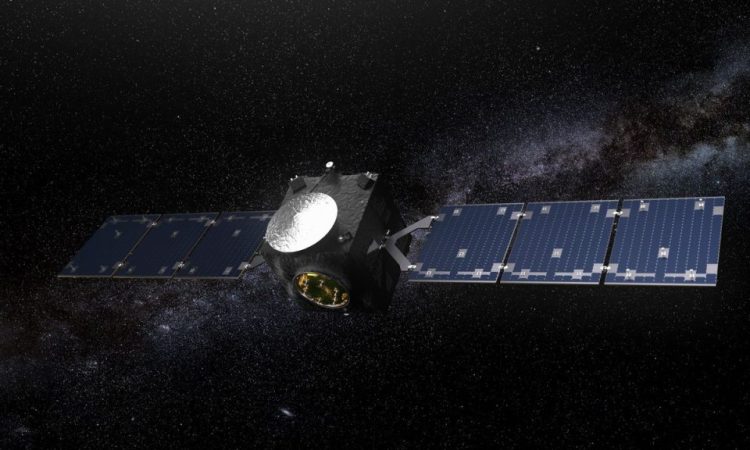
The Hera probe begins its journey to study the asteroid Dimorphos after its orbit was diverted by the DART mission.
Hera it’s one mission european led by ESA for Planetary Defense, developed as part of a larger international effort, the Asteroid Impact and Deflection Assessment (AIDA) collaboration. In the first part of AIDA, the DART mission from the NASA hit the asteroid Dimorphos to change its orbit around the larger asteroid Didymos. Now Hera will visit this asteroid pair to collect additional data on Dimorphos and the outcome of the DART impact, to help transform this method of planetary defense “kinetic impact” in a well-understood and potentially repeatable technique. In addition to serving planetary defense, Hera will also demonstrate new technologies in deep space, including inter-satellite links connecting a spacecraft and its two CubeSats, as well as collecting bonus science on asteroids. Takeoff is scheduled for the day of TodayMonday 7 October, .
Destination Dydimos and Dymorphos
Didymos is a near-Earth solar orbit that extends beyond Mars. The mountain-sized primary body has a diameter of about 780 m and a rotation period of 2.26 hours, while the secondary Dimorphos body, roughly the size of the Great Pyramid of Giza, has a diameter of about 150 m and orbits around the primary at a distance of about 1.2 km from the primary surface in 11 hours and 55 minutes (initially).
Initially nicknamed “Didymoon,” the International Astronomical Union assigned it its current name in 2020, from the ancient Greek for “having two forms.” This reflects its status as the first body in the Solar System to have had its orbit measurably changed through human action, since the DART impact, which is predicted to have reshaped much of the asteroid’s surface.
Astronomers have studied the Didymos system simply by observing “light curves,” slight changes in the combined light of the two bodies over time, along with radar observations during its close approach to Earth in 2003. But DART’s approach showed that Didymos had the “spinning top” shape seen in many, while the smaller Dimorphos had a much rockier surface, although the boulders seen are surprisingly large, typically the size of cars or houses.
Most 1 km-class near-Earth asteroids in our own have been detected and tracked, but most asteroids in the Dimorphos size class (and there are up to 30,000 of them) have yet to be discovered, despite their potential to “destruction of cities”.
Passione Astronomia has always tried to build, through scientific dissemination, a community of more informed and aware people. It is also the reason why many people like you have subscribed to Passione Astronomia and become an integral part of it every day. The more we are, the better off we are, and for this reason we also invite you to take it into consideration : your support helps us continue our project.
The consequences of the DART mission
On September 26, 2022, the vending machine-sized, approximately half-ton DART probe has 6.1 km/s. The collision was observed by the nearby Italian LICIACube, as well as images from the James Webb and Hubble space telescopes, as well as ground-based observatories. Observations show a giant plume of debris that stretched more than 10,000 km into space and lasted for months, as well as a total of 37 meter-sized boulders thrown away by Dimorphos. Light curve observations from Earth confirm that this experiment was a success: Dimorphos’ 11-hour, 55-minute orbit around its parent asteroid Didymos was shortened by about 33 minutes.
While the kinetic impact of DART around its parent body, many unknowns remain that will need to be resolved to turn this large-scale experiment into a well-understood technique that could be repeated if ever necessary to safeguard the Earth.
For starters, researchers don’t yet know how the asteroid as a whole reacted to the impact of the space probe. How much material was thrown into space by the impact? The gives an extra “boost” to the overall efficiency of momentum transfer. This value is known as the “beta factor”. But to interpret the impact result, including the beta factor, and to be able to scale that result to another asteroid if necessary, requires an accurate measurement of the asteroid’s mass, as well as its composition and structure, all of which can be obtained only by visiting the Didymos system.
We also don’t yet know whether DART’s impact left a crater on Dimorphos or whether the asteroid was completely reshaped, as suggested by impact simulations and recent ground-based observations. Our current measurements of Dimorphos’ altered orbit are also stuck with a residual uncertainty of 10%. Hence Hera’s need to carry out a close investigation of the Dimorphos impact site.
Once launched, Hera will begin a two-year cruise phase. An initial deep-space maneuver in November 2024 will be followed by one offering a rare and exciting view of Mars’ moon Deimos in March 2025. A second deep-space maneuver in February 2026 will line up Hera for arrival at the Didymos binary asteroid system . A third maneuver in October 2026 will bring Hera close to the asteroid system for orbit insertion.
Read more

